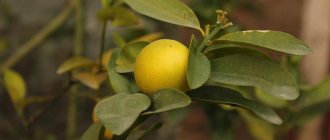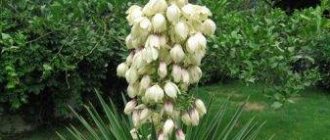Lemon is a popular ornamental crop that is popular not only because it can be grown at home.
The fruits of the lemon tree of certain varieties have a pleasant taste similar to fruits from trees grown in gardens.
Description of indoor plant
Beginning gardeners are interested in what a lemon is: a berry, a vegetable or a fruit. According to botanical features, lemon is a plant that is part of the Rutaceae family, the Citrus genus, and the Pomerantaceae subfamily.
Lemon tree - decoration of home and garden
Breeding of Pomeranians occurs when different varieties are crossed with citron. Citrus fruits differ in size, but in terms of morphological properties they belong to berries that have undergone changes in the process of varietal breeding. Lemon is the name of the hybrid fruit of this crop.
The homeland of the lemon plant is considered to be China and India, as well as the tropical islands of the Pacific Ocean. Lemon does not grow in the wild - the hybrid formed spontaneously and developed as a special species. Subtropical climate is the main condition for successful growth.
Additional Information. Lemon appeared in Russia in the 17th century. Dutch merchants brought seedlings of lemon trees to the court of the Russian emperor. The lemon caretaker took care of the useful and valuable crop.
In the CIS countries, lemon is grown in Central Asian territories and Transcaucasia (especially Azerbaijani regions, where the plant is cultivated as a creeping crop) .
Lemon trees belong to evergreen plants. With the arrival of winter, they do not shed their leaves, which are a storage and accumulator of nutrients. Plants spend reserves on the development of branches, shoots, and fruiting.
Lemon leaves are large, leathery, and rich green. They live 2-3 years and fall off gradually. A sharp drop of leaves indicates disease and the need for feeding. Loss of leaves negatively affects fruit formation.
Flowering occurs in March-April. The formation of buds occurs on young stems of this year. The showy citrus flowers have a fragrant scent. Their location (singly or in inflorescences of 3-5 pieces) is determined by the variety.
Lemon loves care
The size of the fruit and color depend on the variety: from orange-yellow to light yellow. The fruits ripen within 8-9 months.
Lemon is a remontant crop; it is characterized by simultaneous fruit development and flowering.
For culture, good lighting and warm, humidified air are preferable. The tree does not tolerate when there is a lack of moisture and lack of air in compacted soil. Temperatures of +50 °C and -7 °C are dangerous for lemon and lead to its death.
Interesting facts about lemons
According to legend, lemon was first brought to Europe by the soldiers of Alexander the Great. The name is translated from Mandarin (Chinese) as “fruit for mothers.” Apparently, in this country it was believed that citrus eased pregnancy and promoted lactation.
Among the ancient Greeks, lemon was considered a symbol of marriage, and among the Spaniards, on the contrary, it was a symbol of unrequited love. Jews in Babylonian exile used lemon fruits instead of etrogs for offerings on Sukkot. During the era of geographical discoveries, these citrus fruits were used to load the holds of ships; they more than once saved sailors from scurvy. The idea is attributed to James Cook.
Citrus first appeared in Russia in the 17th century. At first it was grown in the royal greenhouses, imported from Holland, and served to the table of the nobility. Then aristocrats began to plant it on their estates. The fruit became available to ordinary people only in the last century.
Everything interesting about modern lemon:
- The largest lemon orchards in the world today are in Sicily.
- The record fruit weighed 5.265 kg, it was grown in 2003 in Israel.
- Record harvests collected from lemon trees are 500-600 pcs. in year.
- Unripe fruits have a matte skin, but they last longer than fruits with a shiny skin.
- If you mix sour juice and salt, you get a cleaner for products made of copper, steel, and brass.
- If you put unripe citrus in the microwave for 20 seconds, it will reach its proper condition.
- To obtain 1 kg of essential oil, you will need skins from 3000 fruits.
- At aristocratic dinner parties, blueberries are always served with lemon. The berry stains the teeth, and the citrus discolors them.
Beneficial features
Lemon tree - how lemon grows and blooms
Lemon is considered a source of valuable minerals and vitamins. Used in cooking. English lemon jam has a sour taste and a delicate consistency.
Medicine cannot do without it. Essential lemon oil has an antibacterial and wound-healing effect. It is indispensable in the following cases:
- stopping bleeding;
- elimination of headaches;
- positive impact on the psyche;
- resolution of dermatological problems;
- removal of toxins;
- cleansing the kidneys and liver;
- prevention of neoplasms;
- strengthening blood vessels and heart;
- excess weight loss;
- normalization of metabolism.
Lemon is very useful
Traditional medicine notes the benefits of lemon for diarrhea and vomiting. In the treatment of snake bites, one could not do without lemon.
Contraindications
Lemon is contraindicated if:
- there is an individual intolerance of the body;
- children under 3 years of age;
- allergy;
- ulcer of the duodenum or stomach;
- gastritis;
- pancreatitis;
- liver dysfunction;
- breast-feeding.
Lemon tree - caring for a houseplant
Attention! To avoid harm and preserve tooth enamel, drink lemon juice diluted through a straw. It wouldn't hurt to rinse your tongue and mouth.
Caring for your plant while on vacation
One of the most pressing questions is how to care for your lemon tree when you go on vacation for a few days. This plant requires regular watering, so it should never be left without moisture.
Remove all flowers and diseased leaves, if any, and then move the tree from the windowsill to the floor, or to another dark place. Remove from the pallet, take a small basin into which pour a five-centimeter layer of expanded clay.
Pour water into the expanded clay and place the pot in the prepared container. The distance from the walls of the basin to the pot is filled with a layer of moss.
How to grow lemon at home
How to grow a lemon tree from a seed at home
Planting and growing a lemon tree at home is carried out using 2 methods:
- cutting;
- bone.
- The third way is to buy a lemon seedling.
It is important for novice gardeners to know how lemon grows at home and what the peculiarities of cultivation are.
A lemon tree grows up to 1.5 m at home. In order for it to grow successfully, you will need the right choice of location. A bright room in the apartment will do. It is advisable to purchase a special lamp to illuminate the crown. Manipulation will reduce the risk of lemon diseases.
If these options are not available, you will need to carefully turn the tree towards the sun every day. It is prohibited to change the location of the flowerpot or move it to another room.
Growing lemon at home
The soil is updated and the volume of the pot is changed annually. The maximum container capacity for lemon is 10 liters. Transplantation is carried out using the transshipment method. 5-year-old plants are replanted after 3 years.
Use a universal mixture for Citrus fruits, which contains equal parts:
- perlite;
- coal;
- peat;
- turf.
Temperature changes are the cause of lemon leaves drying out and turning yellow. It is important to keep the tree away from radiators that are on. Avoid overheating of the root system. The fruits set if the temperature is +17…+18 °C.
Shedding of the ovary is provoked by:
- lack of nutrients;
- dry air and soil;
- drafts;
- excess moisture:
- lack of lighting in the winter season;
- turning in different directions and changing places.
On a note. In order for the culture to develop normally, sufficient lighting is required: 8 hours in winter, 12 hours in summer. It is recommended to place it near a bright window and provide additional lighting with a lamp at a distance of 0.5 m from the lemon.
How to grow a lemon from a seed and care for it
An evergreen bush that produces beneficial essential oils and phytoncides can be easily grown from one seed. The result is a compact tree with fragrant flowers and dark green fleshy leaves.
You need to start by choosing a beautiful large fruit. After cutting it, you need to extract the largest and thickest seeds. There is no need to dry them, otherwise there is very little chance of germinating them. It is better to treat the seed with any biostimulant. Then it will germinate faster and more efficiently. For a good result, you need to dilute the composition according to the instructions and leave the future lemon in it overnight.
While the seeds are soaked, you need to prepare soil and containers for sowing. These can be mini pots from the store or improvised plastic dishes. Drainage is laid at the very bottom, having previously formed holes at the bottom. You need to plant a lot of seeds at once. Not all of them will germinate, and you can choose the best ones among those that have sprouted. The easiest way to plant lemons is in loose purchased soil. If you wish, you can prepare the soil yourself: mix humus, sand, peat and leafy soil in equal parts. Place the mixture in pots, moisten them and immerse the seeds in them to a depth of two centimeters. Crops should be stored at temperatures above 18 degrees. It is also recommended to cover the cups with something to create greenhouse conditions.
There is no need to water the crops; regular spraying from a spray bottle is sufficient. You need to wait two to four weeks for germination. When the seedlings form four leaves, they can already be considered full-fledged plants. At this time, you can choose the healthiest ones and transplant them into full pots. It would be better if it was earthenware. Before transplanting, such pots are soaked and drainage is placed on the bottom. The composition of the soil can be left the same.
Feeding young lemons should be done in the spring. The plant will require additional lighting in the cold season. It is also important to regularly replant the tree into a pot of more suitable volume. It is recommended to do this in June or February. Fertilizers need to be alternated: mineral fertilizers are replaced with biofertilizer. They should only be liquid.
In the first year of growth, the tree needs to be pinched. This way you can achieve intensive growth of side branches. Regular turns of the pot a quarter to the sunny side will make the crown proportional. If a lemon blooms in the first year, it is recommended to pick off all the flowers - the plant spends too much energy on them. In order to bring the fruiting stage closer, it is recommended to graft an adult plant with other citrus fruits.
Types and varieties for indoor growing
Systematic care and creation of the necessary conditions will allow you to grow a lemon tree at home. The correct selection of varieties is appreciated. What species are suitable for indoor growing?
Pavlovsky
When growing Pavlovsk lemon, care at home ensures growth of up to 2 m and flowering throughout the year. The lemon tree bears fruit for 3 or 4 years. The tree will be pleased with 20-40 fruits. One piece weighs up to half a kilo.
The description of the variety speaks of abundant lemon flowering. Untimely removal of excess inflorescences is fraught with the cessation of its growth.
Meyer
The hybrid variety leads in popularity. It was created by crossing grapefruit with lemon. The low tree bears fruits 3 or 4 times annually; fruits weigh up to 150 g. Meyer lemon requires thorough care:
- spraying foliage;
- protection from drafts;
- enough light.
Excessive lighting is undesirable due to inhibition of flower setting.
The green pet will bear its first fruits at four years.
Meyer lemon blossoms
Chinese
If you cross an orange with a lemon you get this variety. When the variety is properly cared for, it blooms beautifully and bears fruit well. Often used for medicinal purposes.
Chinese lemon
Anniversary
The undemanding variety reaches 1.2 m. Ideally adapts to home conditions. An unpretentious crop grows in partial shade.
When flowering, it is covered with abundant white and purple buds. The weight of early ripening fruits varies from 300 to 500 g. The shape is round or oval. The taste is excellent.
Genoa
Belongs to a rare type of lemon. Fruit weight is on average 110 g. Adults bear up to 180 fruits annually. The skin of the fruit is edible, without bitterness, the flesh is tender. The lack of light in the required amount affects the poor development of lemon.
Lisbon
The Australian variety is cultivated with success indoors. The height of the tree is average. Oval-elongated fruits with a wrinkled tip and thin shiny skin. The pulp has from 9 to 11 lobules.
Lemon Lisbon
The fruit usually has 4-5 seeds and a pronounced aroma. Fruits are easily transported and stored.
Maykop
The creation of a variety of folk selection dates back to the city of Maykop, where amateur gardeners grew a lemon tree by selecting seedlings. The yield of an adult lemon tree is 300-350 fruits.
The plant adapts well to unfavorable indoor conditions. Advantage: dwarfism.
Buddha's hand
Lemon is also called Corsican lemon, or palmate lemon. It has an unusual shape - a half-closed hand with fingers.
The fruit-bearing citron loves warmth and is afraid of cold. Reaches a height of 1.5 m. The intense green leaves are large, slightly wavy, shiny. The color of large buds is white with a reddish tint.
Unusual lemon - Buddha's hand
The length of citrus fruits is sometimes 40 cm. The fruit weighs up to 500 g. The color is yellow, sometimes orange specimens are found. The citron peel is dense, reaching a thickness of 2.5 cm. Externally, the fruits are similar to bananas. The plant has a wonderful aroma.
Ponderosa
The height of the tree reaches 1.8 m. The distinctive features of the fruit are their size and shape: pear-shaped on top and spherical on the bottom. The skin is too rough and thick, lumpy, matte. The light yellow flesh is similar to an orange, but sweeter. The fruit includes:
- ascorbic acid – 40-80 mg;
- citric acid – 5-8%;
- sugar – 2.5%.
The lemon tree is decorative when it blooms and bears fruit.
Volcano
It is a hybrid of kumquat and lemon. The tree is characterized by a decorative appearance and compact size. The diameter of the fruit is 4 cm, the taste is sour and bitter.
Lemon Vulcan
Lunario
The variety, in demand among florists, bears fruit twice a year. At the flowering stage, you can see ripened fruits and flowers along with the ovaries. The growth of the Lunario lemon plant is from 0.8 to 1.5 m.
Novogruzinsky
Designed for enclosed spaces. The medium-sized tree has a spreading crown. The oval fruit has a wide, blunt protrusion at the end. The peel is pale yellow, smooth or rough, thick.
Variety Novogruzinsky
The juicy pulp usually has 9-12 segments. There are few seeds: from 2 to 6 pcs.
Uzbek Tashkent orange lemon: description and care
Optimal conditions for Tashkent lemon are if the temperature is +18…20°C. In summer, sometimes the crop is taken out onto the loggia in the absence of strong sunlight.
Lemon tree Tashkent variety
Watering mode
It is not recommended to water Uzbek lemon frequently. 2-3 waterings per week are enough. Use settled water. The alkali content in the water changes the acidity of the soil where the seedling grows. For the tree, this is fraught with death - it likes a slightly acidic substrate. In the winter season, moisture is reduced.
Orange lemon benefits from moisture in the air around the tree. You will need to spray the plant twice a day in hot weather. When the crop is located near heating devices, the air is periodically humidified.
Top dressing
Guests from Uzbekistan are fed:
- ash;
- humus;
- saltpeter;
- mineral fertilizers;
- potassium;
- superphosphates.
Important! The soil is not fed for the first year. Complex fertilizers are applied for 2-3 years with the arrival of spring and autumn.
Diseases, problems, pests and treatment
The lemon tree can suffer from improper care. Overwatering, dry air and restlessness of the tree can lead not only to loss of decorativeness, but also to the death of the plant.
Violation of maintenance rules often leads to the appearance of fungal diseases (sooty fungus, root rot, scab, warts). It will take a long time to treat the tree for these ailments, providing additional care and treatment with fungicides.
Injuries to the bark during pruning can cause infection with an infectious disease called gommosis or gum disease. In this case, you will have to treat damaged, oozing wounds by regularly treating them with antiseptic drugs and cauterizing them with garden pitch. To avoid this disease, all cuts, breaks and damage should be immediately treated with crushed activated carbon.
Despite the abundance of essential oils in the lemon tree, it is very tasty for parasites. Garden slugs, aphids, mealybugs, nematodes and spider mites are very fond of lemon. They can be expelled with commercial insecticides and home remedies, such as tinctures of onion, tobacco, garlic or liquid soap solutions.
Meyer lemon: description and care at home
The Meyer lemon tree requires good lighting: at least 12 hours a day. When daylight is short, artificial lighting is just right, otherwise the lemon will shed its leaves and die.
An unheated room is not the best place for a tree.
Feels comfortable in the summer at a temperature of +20 °C, in the winter season – +12…+15 °C. When outdoors in summer, provide shade for the shrub from direct sunlight.
Watering mode
Watering the lemon is carried out at the root and along the foliage. At the same time, moisten the soil and spray the leaves with a spray bottle. In the spring-summer season, the manipulation is repeated twice daily: in the evening and in the morning. In autumn and winter, the frequency of watering per week is increased to 2 times. Drying out the earthen clod is fraught with the death of the lemon.
Top dressing
During the growing season, gardeners feed the crop once every 14 days from March to November. Apply fertilizers that contain nitrogen, phosphorus or potassium.
Attention! To improve the productivity of mineral fertilizers, once every 2-3 months the soil is sprayed with a solution of copper, boron, zinc, molybdenum, iron or manganese.
For the winter, plant feeding is stopped.
Pavlovsk lemon: description and care at home
Watering mode
Lemon is sensitive to soil moisture in the pot. Drying out of the soil and excess moisture are the reasons for slowing growth, dropping leaves and stopping fruiting.
Water the tree 2-3 times weekly in summer, once a week is enough in winter. Changes in the frequency of humidification are associated with the characteristics of the room. The dryness of a clod of earth is determined by touch and the frequency of watering is adjusted. Moisten the soil abundantly. Rainwater is ideal. They use water from the pond. Tap water must settle.
Important! Do not allow liquid to stagnate at the bottom of the container, otherwise the roots are at risk of phytodiseases and rotting.
Top dressing
The introduction of nutrients into the flowerpot begins 6 months after transplanting into new soil. Deficiency is indicated by pale and curled tips of leaf blades.
Diluted horse manure in a ratio of 1:15 is effective for homemade lemon. In urban conditions, complex fertilizers are used for citrus plants. They are characterized by accessibility, safety and ease of use. The dosage is calculated based on the recommendations on the packaging.
Lemon propagation methods
Bone
A lemon tree can be grown from the seeds of store-bought lemons. To do this, you need to remove several seeds from the fruit and plant them at a distance of several centimeters from each other in a mixture of peat and flower soil (1:1), to a centimeter depth.
The container for seed germination should first be filled with a good layer of drainage. The soil in the container should be kept moderately moist. The seeds will begin to germinate in 15-20 days. The sprouts need to be covered with a transparent cap (plastic or glass jar).
The sprouts should be kept warm, well lit and regularly ventilated from condensation. In such conditions, seedlings should live until several leaves appear. Strong specimens with foliage can be picked and planted in a personal small pot.
The substrate should be changed to a mixture of humus and flower soil. There should be drainage at the bottom of the pot. The sprout should spend several months in this mixture until it gets stronger and grows to 20-30 centimeters. Only then can it be transplanted into a citrus substrate, into a container slightly larger than the previous one, and care for it can begin as if it were an adult lemon, shaping its height and crown.
A tree grown from a seed will begin to bloom and bear fruit no earlier than after 7 years.
Cuttings
To obtain planting material in the form of cuttings, you need to choose a healthy, not too thin (about 5 millimeters in diameter) branch. Cut it into pieces of ten centimeters (+ - cm) so that on each lobe there are several buds and a couple of leaves.
The tops of the leaves should be trimmed, and the cuttings themselves should be cut at both ends with pruning shears at an angle of 45 degrees. Place the finished cuttings in water for several days or in a root growth stimulating liquid for several hours.
The cuttings are planted in a moist mixture of coarse sand and flower soil (1:1). The rooting process takes from several weeks to one and a half months. When the cuttings begin to produce new leaves, they can be planted in stationary pots.
Sapling
Ready-made lemon tree seedlings can be purchased in specialized stores and planted in citrus soil at home. Purchasing adult lemon tree specimens should be avoided, as the plant does not tolerate changing conditions and transportation well, and may die a few weeks after changing the location.
Lemon Panderosa (Ponderosa): description and care at home
Ponderosa is almost never grown in open ground due to the excessive size of the fruit and low yield. Old trees produce a maximum of 10-15 fruits; indoors the yield is even lower - 2-5 pieces.
Watering mode
The lemon tree is not afraid of dry air, but it likes spraying. In winter, at high temperatures at home, it doesn’t hurt to place a bucket of water next to the crop. When the summer is dry, the air is humidified. In rainy weather, open the window.
Watering homemade lemon
When watering, completely moisten the earthen ball. The next watering is carried out when the soil has dried to 2 cm in depth.
Top dressing
Recharge regularly. Fertilizers for citrus fruits are preferable. They contain the necessary nutrients for lemon, as well as a complex that acidifies the substrate. When fertilizing with other fertilizers, add a few drops of lemon juice to the water every month.
During the warm season, they are fed systematically: once every week and a half. Keeping the tree at low temperatures does not require fertilizing.
New Zealand lemon: description and care at home
When grown in soil, the hybrid can withstand frosts down to -5°C. You rarely see it in open garden beds. Lemon is in demand for home cultivation.
On a note. This variety of plant is not cultivated in New Zealand.
Watering mode
New Zealand lemon is watered 2 times a week indoors. During the active growing season, from late spring to early autumn, the soil is moistened daily in small portions. Moisten with settled lukewarm water.
Spraying leaves
When the air in the room is dry, especially in winter, foliage is sprayed with warm liquid in a moderate volume.
Top dressing
Tree fertilization is carried out according to the age and growth period. Seedlings are fed after 1.5-2 months, adults are fed in spring and summer after 2-3 weeks. With the onset of autumn, the frequency of fertilizing decreases and stops for the winter period.
Fertilize the lemon with mineral mixtures for flowers, organic matter, which is diluted with water: ash extract, fresh manure, herbal infusions (birch or quinoa, half a jar of leaves is poured with boiling water and allowed to brew in the dark for 2-3 days).
Lemon feeding
Before feeding, the tree is watered 2 hours in advance so that the nutrients are better absorbed.
Preparing cuttings for planting
After a few days, you can start replanting the branch from the water into the solution we prepared. Since the roots have not yet formed, the plant will not be able to adequately provide itself with moisture, so it is necessary that the depth into which the cutting will be placed is no more than three centimeters.
Regularly spray the leaves and the stem itself from the sanitizer with water. The optimal ambient temperature should be twenty degrees. After five weeks, the cutting can be transplanted into a pot to give the root system some time to strengthen.
Lemon Novogruzinsky: care at home
According to the characteristics, the variety gives a generous harvest every year. The tree bears fruit in the 4th or 5th year, later than other varieties.
Watering mode
Correct watering is responsible for the healthy development of roots, foliage, and fruit ripening. With water, lemon receives nutrients. The watering regime is determined by the season and the growth activity of the crop: from May to September, daily watering is carried out; from October to mid-spring water 1 or 2 times weekly.
Water the plant with a moderate amount of water. Excessive soil moisture causes root rot and leaf damage. Watering the lemon tree is carried out with liquid at a temperature of +20…+25 °C. Spray the lemon with water twice a week in the summer, and 2 times a month in the winter.
Note! Do not overdo it with moisturizing the foliage, otherwise mold will develop.
Top dressing
The plant grows quickly, the soil is depleted. Ripe lemons require more fertilizer. In spring and summer, fertilize once every 2-3 weeks. In winter, additional mineral supplements will be required.
When the lemon does not rest in winter, it is fed once a month. The culture needs mineral supplements and organic matter. Diluted manure will come in handy.
The influence of feeding on the development of citron
Nitrogen is obtained from organic substances and complex fertilizers. Liquid mineral mixtures are preferable. The intensive growth of the New Georgian lemon and the lack of fruiting will require an increase in phosphorus in the feed. You can refuse organics during this period.
Why lemons don't bloom at home
Often, a lemon tree blooms intensely, but the ovaries soon fall off and fruits do not form. Among the reasons why lemon does not bloom are:
- No cross-pollination. To solve the problem, transfer pollen yourself during the flowering period using a brush or cotton swab.
- Damage to crops by pests.
- There is no rest period. Lemon did not regain his strength.
- Nutrient deficiency. Regular replenishment is required.
- Lack of light.
The way a lemon blooms determines not only diseases, but also the suitability of the container for the lemon.
For proper care, an indoor lemon will thank its owner and delight it with sunny fruits. The main thing is patience and desire.
Soil preparation
The correct selection of soil composition for lemon is especially important, since it must not only nourish the plant, but also retain moisture with abundant watering and at the same time be sufficiently loose. Equal proportions of humus, deciduous soil, sand, peat should be mixed with 2 parts of turf, or purchase a ready-made package of soil mixture for citrus fruits.
Annual replanting of the plant is required only in the first 3 years, when increased growth occurs and it is necessary to change the pot, while it is necessary to spare the roots as much as possible: pull the plant out of the most moistened soil, and carry out the transfer without shaking off the soil.











